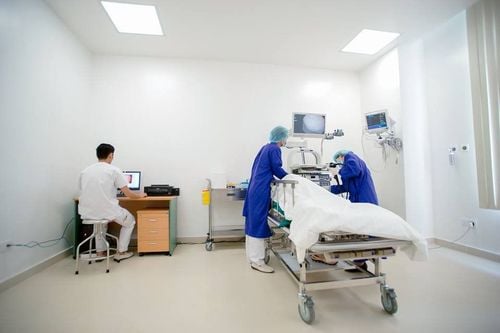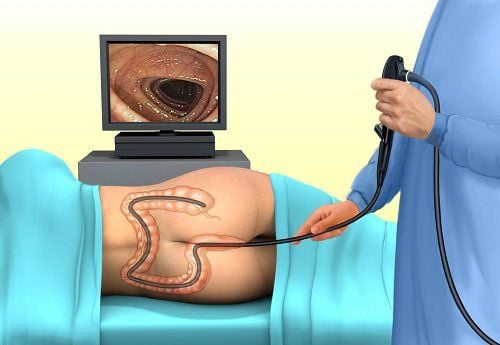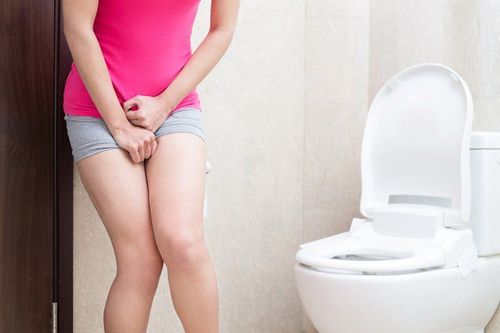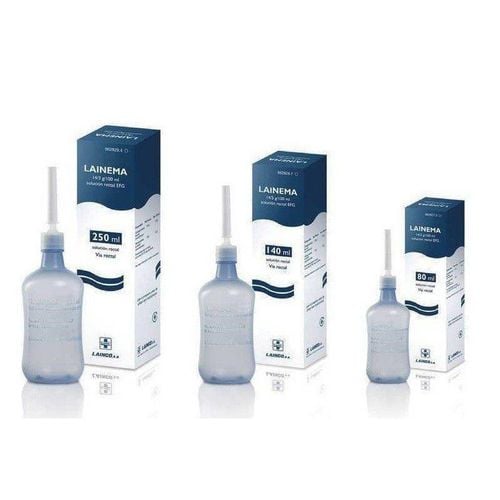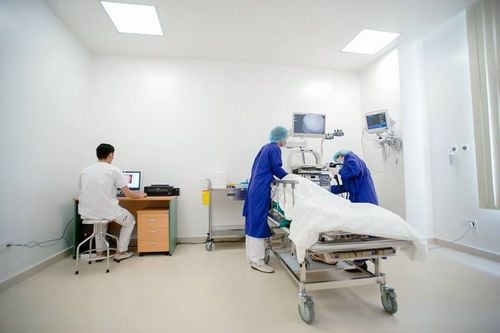This is an automatically translated article.
The article was professionally consulted by Doctor Department of Medical Examination & Internal Medicine - Vinmec Hai Phong International General Hospital.
Colonoscopy is a safe, important method of colon cancer screening, early detection of precancerous lesions (polyps) and small tumors in the intestinal tract to remove before they appear symptoms. other dangerous conditions.
1. What is a colonoscopy?
The rectum is the last part of the large intestine, the bridge between the anus and the colon. The function of the rectum is to store waste, along with peristalsis to expel stool through the anus. Because of a number of reasons, the rectum often suffers from diseases such as inflammation, polyps, rectal cancer, .... Therefore, colonoscopy is a very important method to diagnose diseases in the rectum, from There are timely treatment methods (if there are diseases), avoiding dangerous complications.
Colonoscopy is a method that uses a flexible tube with a camera with a small diameter through the anus to go through the rectum into the colon to check the condition of the inside of the colon. Colonoscopy includes:
Colonoscopy without anesthesia: The patient is fully awake during the colonoscopy, but the patient may feel pain, abdominal pain depending on the feeling. Colonoscopy under anesthesia: The doctor will anesthetize the patient for the endoscopy. This method helps the patient not to feel any discomfort or pain during the colonoscopy. Patients can be discharged immediately after endoscopy 1-2 hours. Besides, in addition to endoscopy without anesthesia and anesthesia, there is also a capsule endoscopy method to diagnose pathologies in the colon. With this method, the patient will have to swallow a small camera. During digestion, the camera will observe the entire digestive tract and record information, the time to observe the entire digestive tract takes from 6 to 10 hours. This is also a passive endoscopic method because it depends on gastrointestinal motility, so the assessment of lesions in the stomach and colon will be limited due to the hidden angle that the camera cannot see.
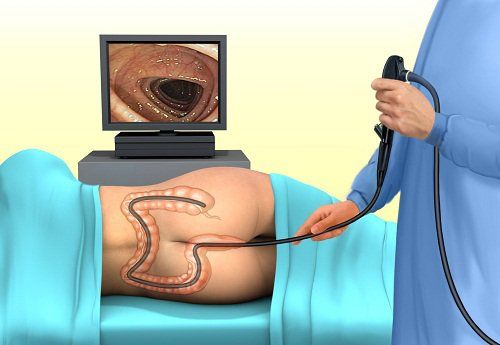
2. When is a colonoscopy needed?
Colonoscopy is often indicated to diagnose diseases such as hemorrhoids, anal fistula, tumor pathology, cancer, colitis, polyps, ... and monitor disease progression in case of surgery. anorectal area. In addition, colonoscopy can also screen and diagnose colon cancer early to help patients receive early treatment and prolong life for cancer patients. Therefore, when the following signs are present, a colonoscopy should be performed:
Feeling abdominal pain below the navel, left iliac fossa and abdominal pain following contractions of bowel movements. Bloody, bright red stools Diarrhea and constipation erratic stool disorders, difficult defecation. Itching and pain in the anal area. Abnormal discharge from the anal canal or outside the anal canal. Screening for colon cancer, periodically checking patients with polyps, colorectal cancer In case of anemia of unknown cause; fecal erythrocytosis test is positive; there are abnormalities on the X-ray: Inflammatory bowel disease, diverticulitis, ulcerative colitis, bleeding, Crohn's, cancer, polyps, anal fistula, anal fissure. Colonoscopy to treat diseases such as: Colon polyp removal, treatment of hemorrhoids, removal of foreign bodies, hemostasis, dilation of strictures Colonoscopy to monitor after polypectomy, severe dysplasia. SEE ALSO: Q&A: Does colonoscopy hurt?
3. Procedure during colonoscopy
Usually, depending on the cooperative attitude of the patient and the doctor, the colonoscopy can last from 20 minutes to 1 hour. The procedure during colonoscopy includes the following steps:
Step 1: The doctor checks the patient's anus for any damage. The patient is then anesthetized, with a lubricant, sedative or pain reliever before the colonoscopy. Step 2: At the beginning of the colonoscopy procedure, the doctor instructs the patient to lie on the left side. Using the endoscope, slowly insert it into the patient's anus, then pass it through the rectum and stop at the colon. Step 3: Injecting carbon dioxide gas into the patient's colon so that it can be easily recognized and observed all the lesions inside the colon lumen. During the endoscopy, the patient will feel discomfort, bloating or pain in the abdomen, if it is too painful, it is necessary to stay calm, lie still and notify the doctor immediately. Step 4: The patient may have to change the lying position a few times to make the bronchoscope easier to enter and see more angles.
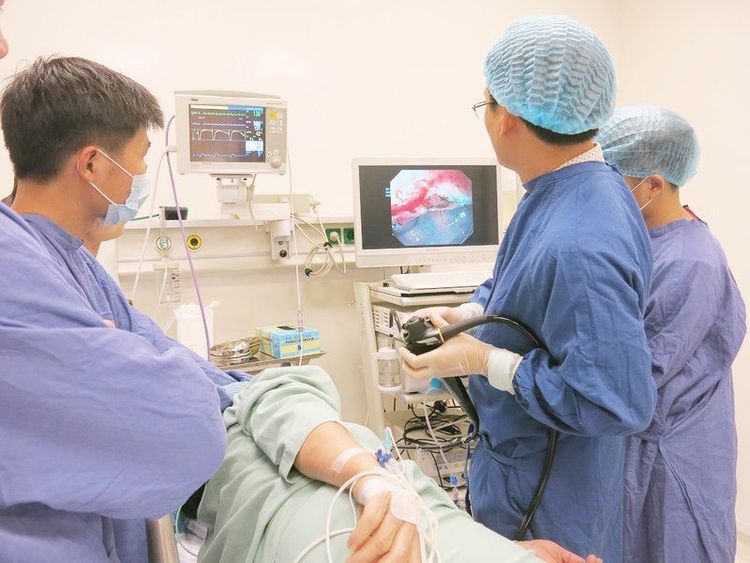
4. Notes on colonoscopy
4.1. Note before colonoscopy is a fairly common and routine technique, but it is still an intervention method and has certain risks. Therefore, you should consider and choose to perform colonoscopy at a reputable medical facility, with highly skilled doctors and modern medical equipment. Note that during colonoscopy, the patient needs to do some blood tests as well as receive medicine to clean the colon at home. Therefore, you should book with your doctor in advance to save time. Regardless of which colonoscopy method you choose, you should ask a family member to accompany you to take you home after the colonoscopy. To help clean the colon, about 4 days before the colonoscopy, you should eat light, low-fiber foods that are easy to digest. Also, stop taking vitamins or other supplements, and if you're on medication, consult your doctor. The day before colonoscopy, it is recommended to drink plenty of water, but stay away from liquids that are blue, red, and purple. For 2 hours before your colonoscopy, do not eat or drink anything. The night before your colonoscopy, you need to take a strong laxative to clear your digestive tract. From the time you take your medicine until your colonoscopy, you will have to fast completely but can drink sugar water if you feel hungry. 4.2. Notes during the colonoscopy During the colonoscopy, you will feel discomfort, bloating or abdominal pain. In case you feel too much pain, you need to stay calm, try to lie still and notify your doctor immediately. During the endoscopy, you may have to change position a few times, sometimes the nurse will gently press on your abdomen to make it easier for the laparoscope to enter and help you feel less pain. 4.3. Note after colonoscopy After colonoscopy, you should rest and relax until the discomfort in the abdomen is gone; You may have a dull pain in the abdomen, bloating, often straining but not having a bowel movement. However, these feelings will gradually disappear and recover by the next day; It is necessary to notify the doctor immediately and stay in the hospital for 1-2 hours after colonoscopy to monitor health if there are serious complications with severe pain, fever, dizziness,... MORE: Cancer treatment colorectal by superior robotic endoscopic technique at Vinmec

Please dial HOTLINE for more information or register for an appointment HERE. Download MyVinmec app to make appointments faster and to manage your bookings easily.




